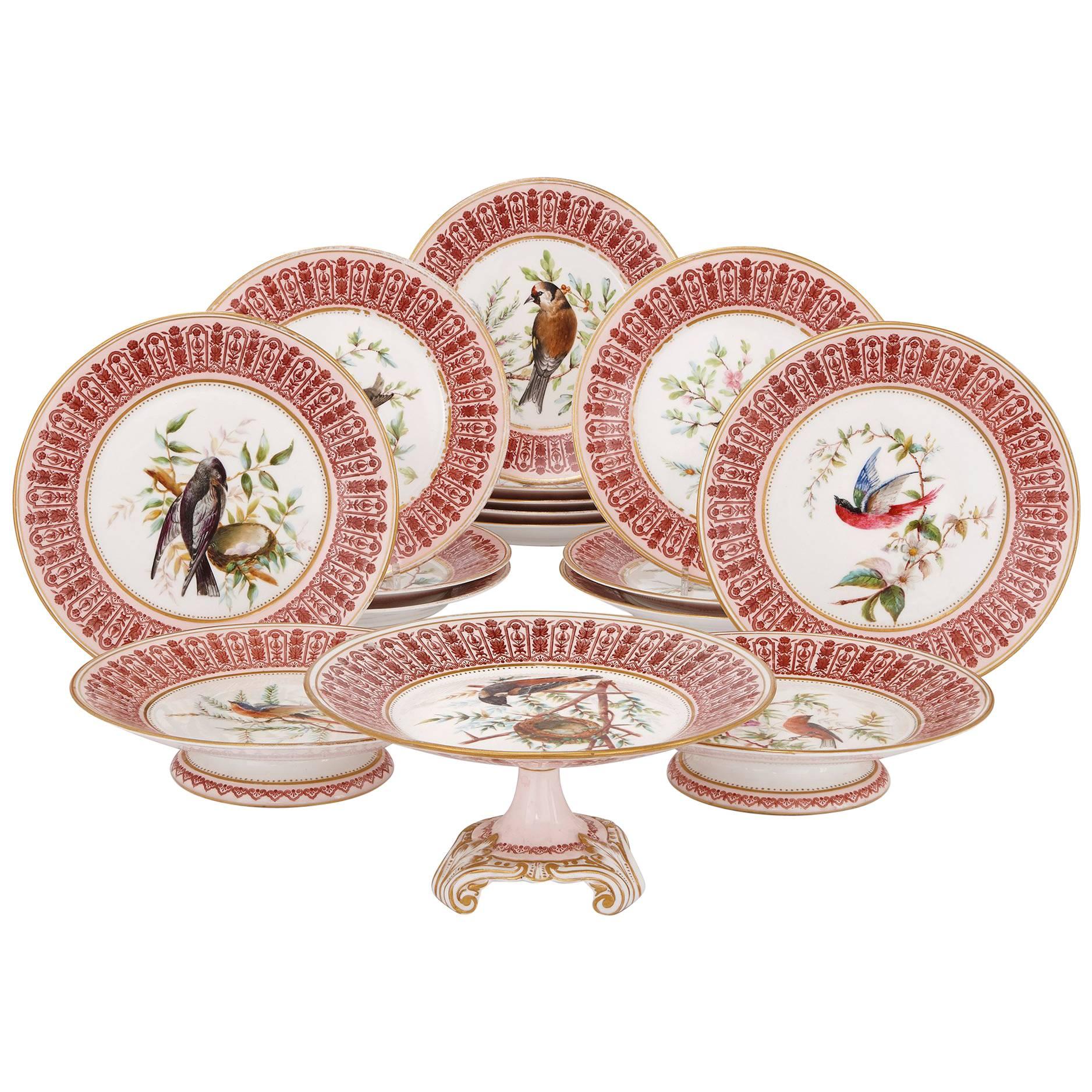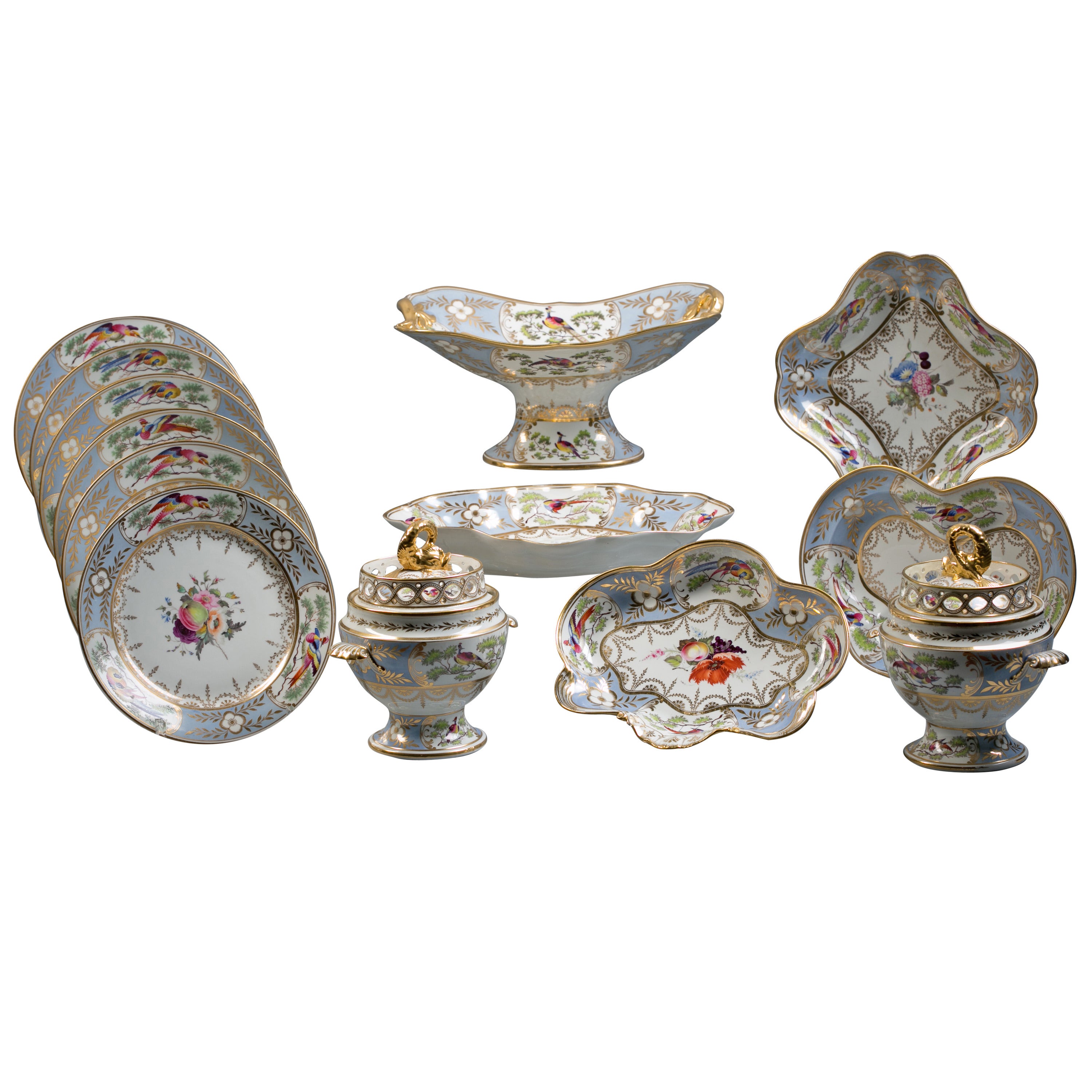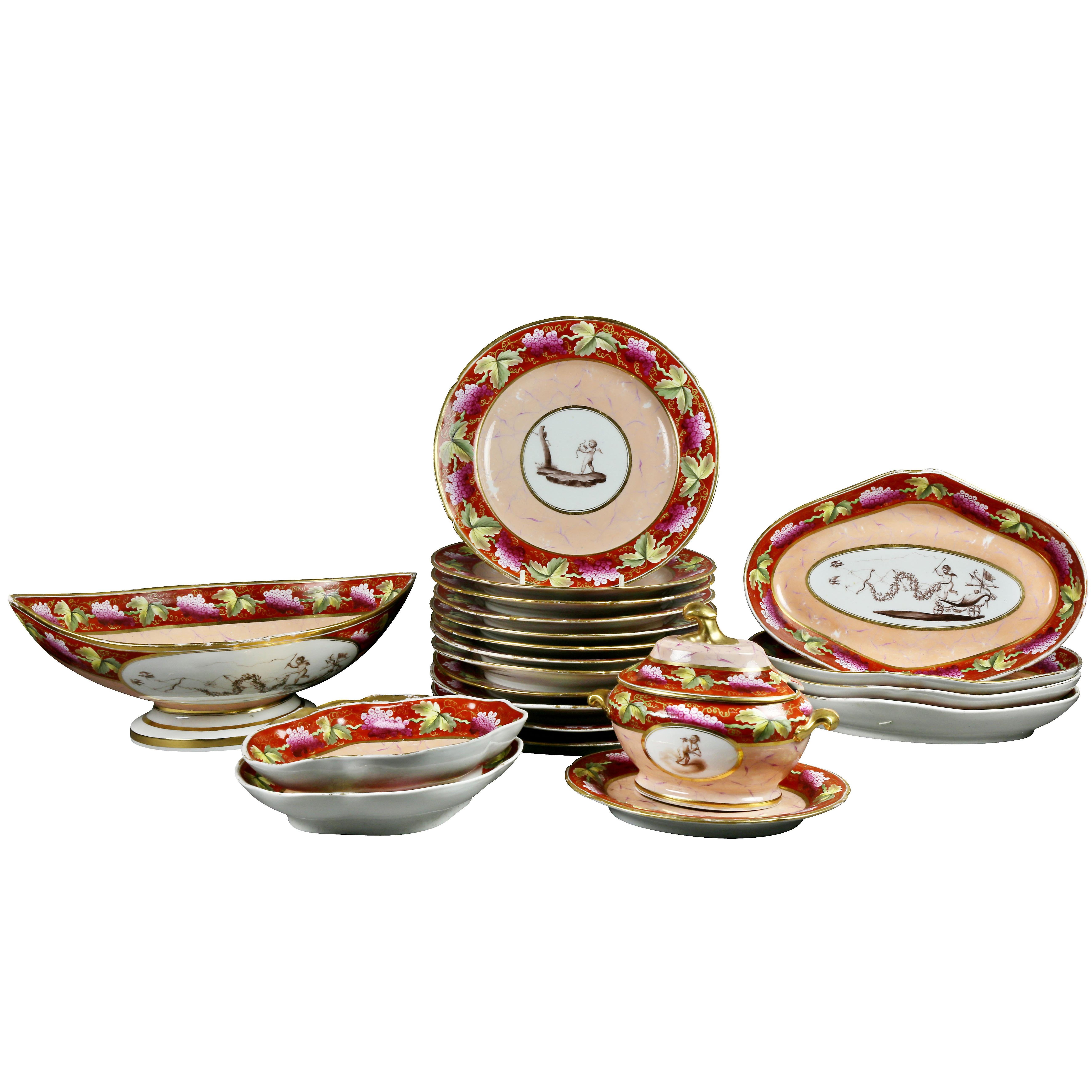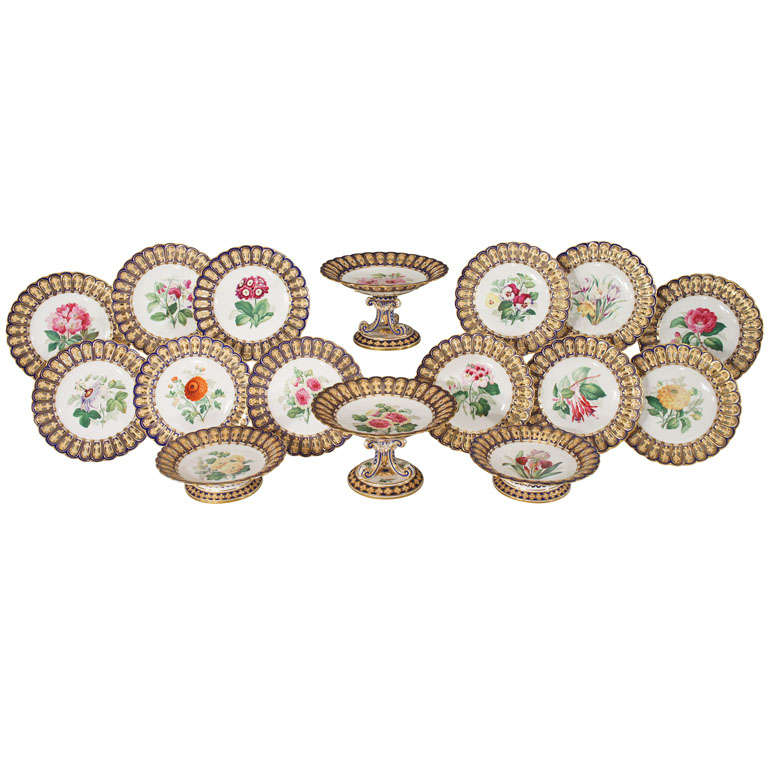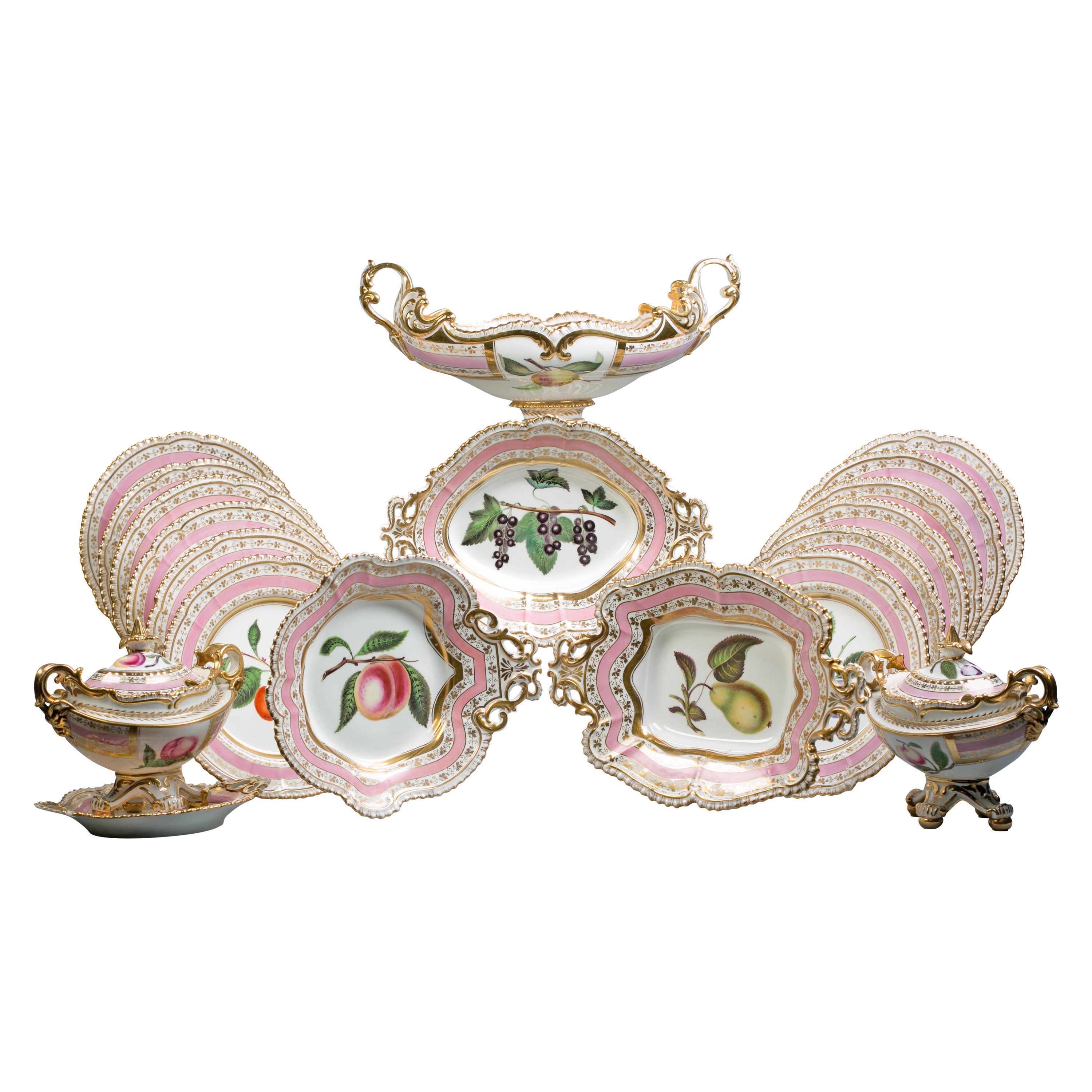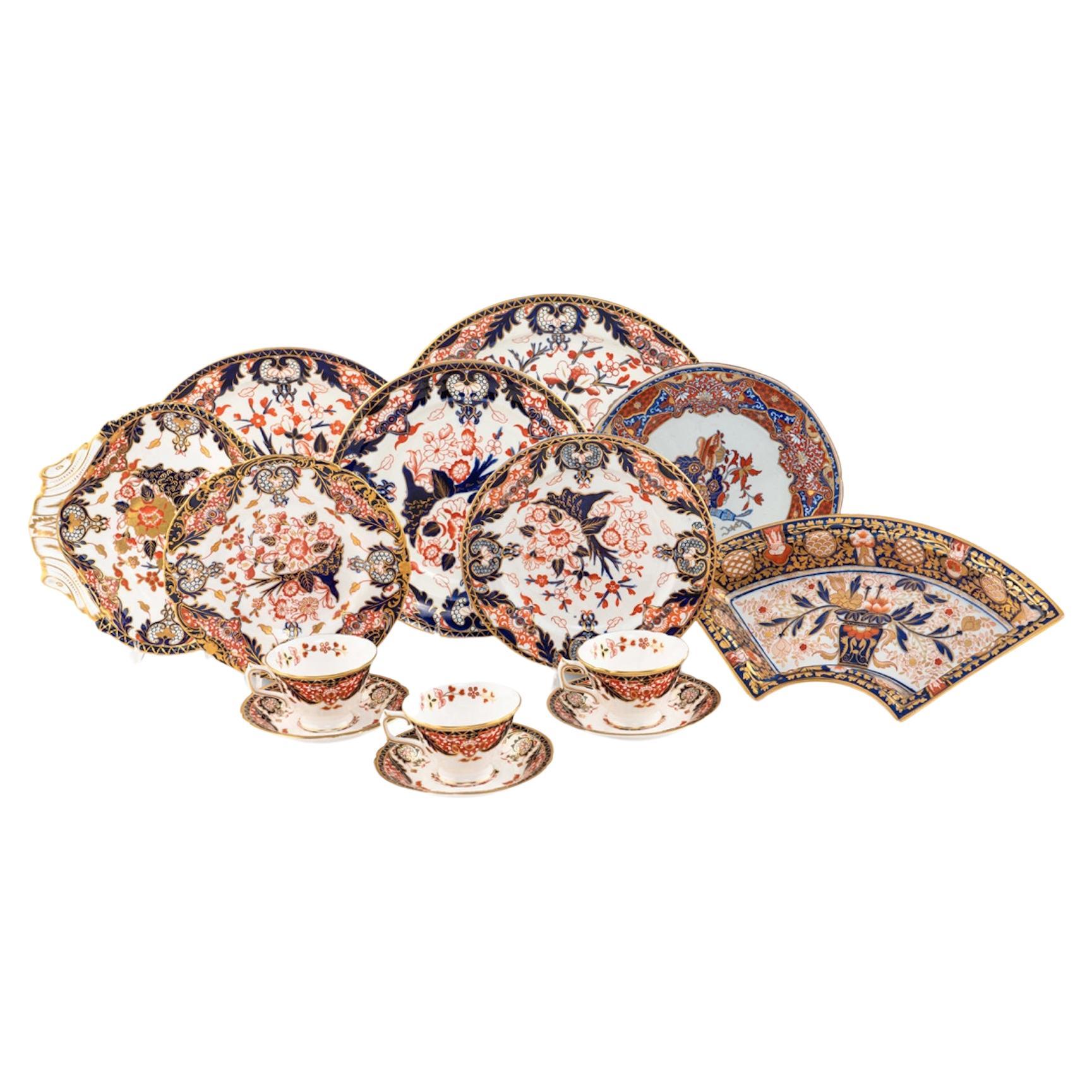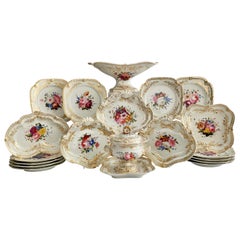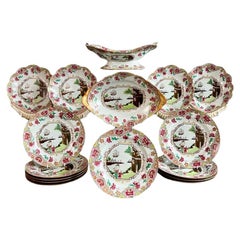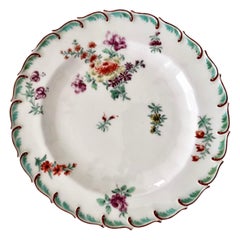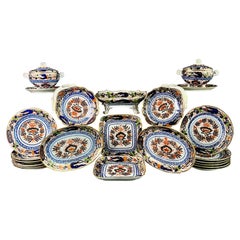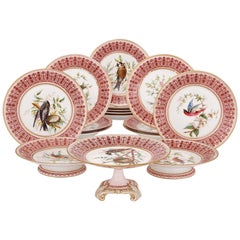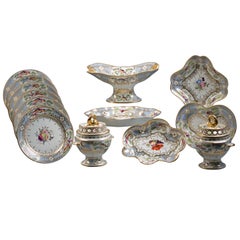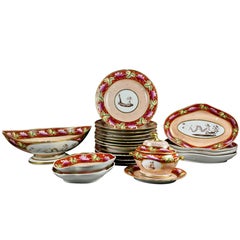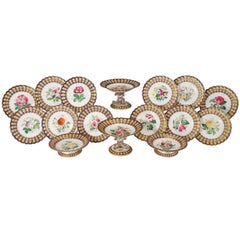Items Similar to Derby Porcelain Part Dessert Service, Red Botanical, John Brewer, 1795-1800
Video Loading
Want more images or videos?
Request additional images or videos from the seller
1 of 22
Derby Porcelain Part Dessert Service, Red Botanical, John Brewer, 1795-1800
$11,500per set
£8,607.58per set
€9,946.16per set
CA$15,946.67per set
A$17,862.31per set
CHF 9,286.42per set
MX$220,563.65per set
NOK 118,301.66per set
SEK 111,835.81per set
DKK 74,223.69per set
Shipping
Retrieving quote...The 1stDibs Promise:
Authenticity Guarantee,
Money-Back Guarantee,
24-Hour Cancellation
About the Item
This is a stunning part-dessert service made by Derby between about 1795 and 1800, painted with named botanical studies by John Brewer. The service consists of a lidded sauce comport on a stand, two kidney shaped dishes, two lozenge shaped dishes, one lozenge shaped low footed comport, one round dish and three plates.
The Derby Porcelain factory has its roots in the late 1740s, when Andrew Planché, a Walloon Huguenot refugee, started making simple porcelain toys shaped like animals in his back yard. In 1756 Staffordshire enameller William Duysbury and banker John Heath started a new porcelain factory with Planché and this was to grow out to the largest factory of its time, buying up the bankrupted Chelsea and Bow factories, as well as the stock of several other workshops including that of James Giles. The combination of various traditions, porcelain making skills and sophisticated clients enabled Duesbury to create one of the best porcelain factories of the 18th and 19th Centuries, which after many ups and downs is still operative today.
John Brewer came to work at Derby in 1795 and worked there until his death in 1816. Together with his brother Robert, he was among the best painters at Derby, famous for his very fine landscapes and botanical studies. The brothers came from a well-known family of artists in London, but as the art scene became more crowded in the late 18thC, they chose to explore new avenues. It is said that John, who had never painted on porcelain, switched from being a water colourist to a porcelain painter within one week; a feat that had never been seen before as painting on porcelain is extremely difficult.
This service is potted in an elegant shape typical for the late Georgian/ early Regency style. The decoration consists of simple warm red rims with gilt bands, and stunning botanical studies on each item. The Latin and English names of the species are neatly painted in long hand on the back of each piece - you can just imagine the guests finishing their plates in order to turn them around and see if they guessed it right!
The items are marked in blue with the Derby crown mark, the pattern number 313 and the latin and English names of the flowers on each item.
Documentation: a full dessert service painted in the same manner by John Brewer but with yellow rims, was sold at Christies on 9 May 2018, lot 15, for USD 68.750.
CONDITION REPORT In very good condition without major damage and no repairs. There is an old crack in the sauce comport, however it is still good for use; there is one chip off the underside of the rim of one of the lozenge shaped dishes, and there is some crazing to the inside of the sauce comport. There is some light wear throughout, as visible in the pictures.
Antique British porcelain is never perfect. Kilns were fired on coal in the 1700s, and this meant that china from that period can have some firing specks from flying particles. British makers were also known for their experimentation, and sometimes this resulted in technically imperfect results. Due to the shrinkage in the kiln, items can have small firing lines or develop crazing over time, which should not be seen as damage but as an imperfection of the maker's recipes, probably unknown at the time of making. Items have often been used for many years and can have normal signs of wear, and gilt can have signs of slight disintegration even if never handled. I will reflect any damage, repairs, obvious stress marks, crazing or heavy wear in the item description but some minor scratches, nicks, stains and gilt disintegration can be normal for vintage items and need to be taken into account.
There is widespread confusion on the internet about the difference between chips and nicks, or hairlines and cracks. I will reflect any damage as truthfully as I can, i.e. a nick is a tiny bit of damage smaller than 1mm and a chip is something you can easily see with the eye; a glazing line is a break in the glazing only; hairline is extremely tight and/or superficial and not picked up by the finger; and a crack is obvious both to the eye and the finger. Etcetera - I try to be as accurate as I can and please feel free to ask questions or request more detailed pictures!
DIMENSIONS please feel free to ask for further details.
- Creator:Crown Derby (Maker)
- Attributed to:John Brewer (Artist)
- Dimensions:Height: 1 in (2.54 cm)Diameter: 1 in (2.54 cm)
- Sold As:Set of 13
- Style:George III (Of the Period)
- Materials and Techniques:
- Place of Origin:
- Period:1790-1799
- Date of Manufacture:1795-1800
- Condition:Wear consistent with age and use. in excellent and usable condition; one insignificant crack in sauce comport, one small chip off a dish, some wear throughout.
- Seller Location:London, GB
- Reference Number:Seller: A-DER331stDibs: LU4805119805912
About the Seller
5.0
Gold Seller
Premium sellers maintaining a 4.3+ rating and 24-hour response times
Established in 2016
1stDibs seller since 2019
225 sales on 1stDibs
Typical response time: 2 hours
- ShippingRetrieving quote...Shipping from: London, United Kingdom
- Return Policy
Authenticity Guarantee
In the unlikely event there’s an issue with an item’s authenticity, contact us within 1 year for a full refund. DetailsMoney-Back Guarantee
If your item is not as described, is damaged in transit, or does not arrive, contact us within 7 days for a full refund. Details24-Hour Cancellation
You have a 24-hour grace period in which to reconsider your purchase, with no questions asked.Vetted Professional Sellers
Our world-class sellers must adhere to strict standards for service and quality, maintaining the integrity of our listings.Price-Match Guarantee
If you find that a seller listed the same item for a lower price elsewhere, we’ll match it.Trusted Global Delivery
Our best-in-class carrier network provides specialized shipping options worldwide, including custom delivery.More From This Seller
View AllChamberlains Worcester Dessert Service, White with Flowers, Regency, ca 1822
By Chamberlains Worcester
Located in London, GB
This is a spectacular and rare dessert service made by Chamberlains Worcester in about 1822. The service consists of a high comport, 2 square dishes, 1 kidney shaped dish, 3 shell di...
Category
Antique 1820s English Regency Dinner Plates
Materials
Porcelain
Spode Dessert Service, Ship Pattern no. 3133 on Stone China, 1813-1822
By Spode
Located in London, GB
This is a stunning and rare Spode dessert service made between 1813 and 1822, consisting of a centre piece, a lozenge shape dish, four shell dish...
Category
Antique 1810s English Regency Porcelain
Materials
Stoneware
Chelsea Plate, Feather Moulded with Flowers, Red Anchor Mark, ca 1755
By Chelsea Porcelain
Located in London, GB
This is a beautiful plate made by Chelsea in circa 1755, which is known as the "Red Anchor" period of the factory.
Chelsea was one of the very early adopters of porcelain in the British china industry. Founded in 1744 the Chelsea pottery was for about 40 years the leading maker of fine chinaware, excelling in their sense of style, perfection and constant innovation and inspiring many following generations of china makers.
The company was started by French silversmith Nicholas Sprimont and you can see the influence of the French style of silverware...
Category
Antique 1750s English George II Dinner Plates
Materials
Porcelain
Coalport John Rose Porcelain Dessert Service, Imari Pattern, ca 1805
By John Rose, Coalport Porcelain
Located in London, GB
This is a rather stunning 25-piece dessert service made by John Rose at Coalport around the year 1805. It consists a centre piece on four feet, two oval dishes, two shell dishes, two...
Category
Antique Early 1800s English George III Dinner Plates
Materials
Porcelain
$3,360 Sale Price / set
20% Off
Free Shipping
Barr Flight & Barr Part Dessert Service, Flowers by William Billingsley, 1808-10
By William Billingsly, Barr, Flight & Barr Worcester
Located in London, GB
This is a stunning and extremely rare part dessert service made by Barr Flight & Barr in Worcester, and painted with naturalistic flowers by William Billingsley between 1808 and 1810. The service consists of one deep central oval dish, four slightly smaller oval dishes, two round one-handled dishes, and six plates.
We also have a pair of Derby ice pails available in a separate listing, painted by William Billingsley in a very similar style. These would make a great match.
Provenance: The Charles Dawson Collection. One of the items has a label of the London Ceramic...
Category
Antique Early 1800s English Regency Dinner Plates
Materials
Porcelain
$12,000 / set
Free Shipping
Minton Dessert Service, Inverted Shell White with Monochrome Flowers, ca 1830
By Minton
Located in London, GB
This is a stunning dessert service made by Minton probably around the year 1830, in their "second period". The service consists of a high footed centre piece, two square dishes, two ...
Category
Antique 1830s English Rococo Revival Dinner Plates
Materials
Porcelain
$5,325 / set
Free Shipping
You May Also Like
Antique English Sixteen-Piece Dessert Service by Royal Crown Derby Porcelain
By Royal Crown Derby Porcelain
Located in London, GB
This splendid antique dessert service is impressive both for its beautiful design and its prestigious maker, Royal Crown Derby Porcelain, which was appointed the official royal porcelain manufacturer to Queen Victoria of England...
Category
Antique Late 19th Century English Victorian Ceramics
Materials
Porcelain
English Chamberlain Worcester Porcelain Part Dessert Service, circa 1815
Located in New York, NY
Comprising footed compote, pair of covered sauce tureens, one gallery (partially restored), pair of lozenge-shaped dishes, pair of kidney-shaped dishes, four shell dishes, four squar...
Category
Antique 1810s English Dinner Plates
Materials
Porcelain
Coalport Pottery Partial Dessert Service
Located in Essex, MA
Decorated with the story of cupid, painted in various pursuits with borders of peach colored marbleized panels, iron red foliate painting. Provenance Taylor B Williams, Chicago. Incl...
Category
Antique Early 1800s English Regency Pottery
Materials
Pottery
$7,500 / set
19th C Minton Hand Painted Botanical Pierced Rim Dessert Service
By Minton
Located in Great Barrington, MA
A complete hand painted dessert service made by Minton showcases their superb talent and artistry. Gorgeous specimens are featured in the centers of each plate, consisting of 12 dessert plates, 2 tall compotes...
Category
Antique 19th Century English Dinner Plates
Materials
Paste, Porcelain
English Porcelain Fruit Service, Chamberlain Worcester, circa 1820
Located in New York, NY
Footed centerpiece.
Pair of covered sauce tureens.
Four rectangular dishes.
Four oval dishes.
Four shell shaped dishes.
20 plates.
Category
Antique Early 19th Century English Dinner Plates
Materials
Porcelain
A Royal Crown Derby Porcelain Dinner Service 19th/20th Century Kings pattern
By Royal Crown Derby Porcelain
Located in Buchanan, MI
A Royal Crown Derby Porcelain/ironstone Assembled Dinner Service
19th/20th Century
Kings pattern, in slight variations throughout, comprising:
12 dinner plates
11 luncheon plates
12 ...
Category
Antique 19th Century English George III Dinner Plates
Materials
Porcelain
